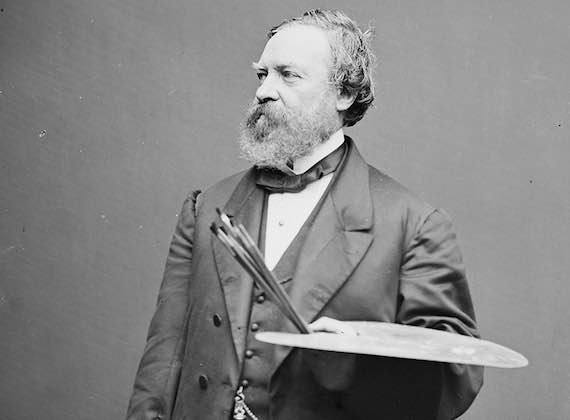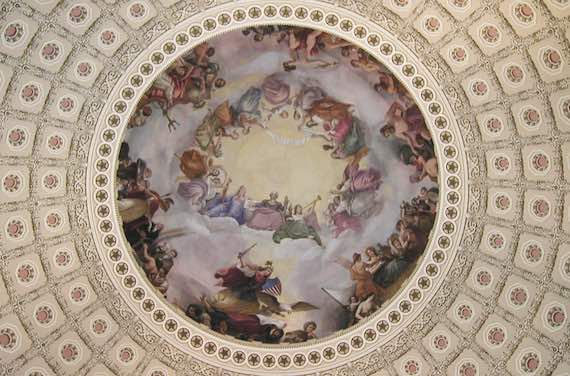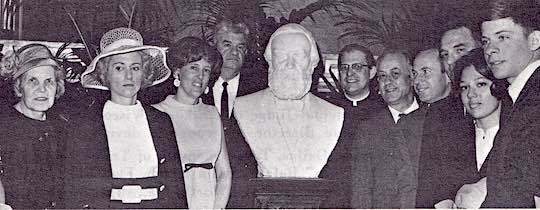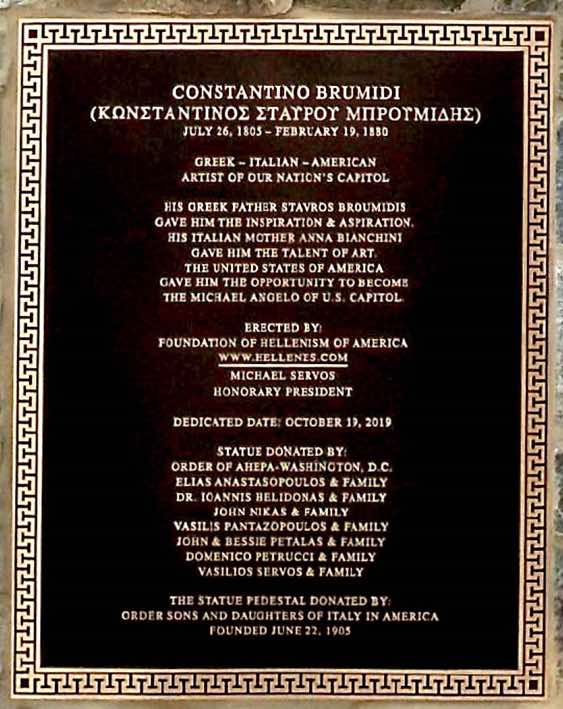Constantino Brumidi

Greek artist Constantino Brumidi (1870)
"C. Brumidi, artist. Citizen of the U.S." This signature on a painting in the House of Representatives Chamber of the United States Capitol in Washington, D.C., is that of Constantino Brumidi, who was also known as the "'Michelangelo of the United States Capitol."
Constantino Brumidi was born in Rome, Italy on July 26, 1805 of a Greek father and Italian mother. His father, Stavros Brumidis was born in Philiana, Messinia, Greece, and immigrated to Rome when a young man during the time when Greece was still under Turkish rule.
Constantino Brumidi was admitted to the Academy of Arts in Rome when only thirteen years old, had an excellent reputation as a painter, and when about 35 years of age he was given the task of restoring some paintings in the Sacred Palaces for Pope Gregory VIth.
In her book "Constantino Brumidi, Michelangelo of the United States Capitol" author Myrtle Cheney Murdock says of his early years in Rome:
About all that is known of the artist's next twenty years is that he became involved in the French occupation of Rome in the year 1849 for the suppression of Republican institutions, and when his friend, Pope Pius IX, was banished from Rome, Brumidi was thrown into prison for fourteen months.
As Captain of the National Guard, Brumidi had refused to obey certain orders against his friends which resulted in the enmity of Cardinal Antonelli, Minister of State. Pope Pius IX was finally restored to the Vatican but he was unable to save Brumidi except on condition that the artist would flee the country and never return. Finally, to save his own life, Brumidi was forced to leave Italy. He reached America in 1852.
Upon his arrival in the United States, Brumidi renounced his Italian citizenship and filed his intent to become a citizen of the United States. He took out his final citizenship papers on November 12, 1857 in Washington, D.C.
He was hired to decorate the Capitol Agriculture Committee Room in 1855, and his brush was busy in succeeding years, with the nation's Capitol building as his canvas. His work included the Senate Reception Room, Senate Appropriations committee room, the President's Room in the Senate extension (a masterpiece of paintings and frescoes on which he labored for 5-1/2 years in that one room), the Senate Floor corridors, the House of Representatives Chamber, the House of Representatives committee room, the Capitol Rotunda. The Rotunda of the Capitol contains his magnificent frescoed frieze of 15 historical groups and is capped by his huge frescoed canopy in the eye of the Capitol dome, measuring some 4,664 square feet of concave fresco.
Author George C. Hazelton, in his book published in 1897, "The National Capitol," says: "Brumidi's work so identifies him with the Capitol Building that he may almost now be called the Michelangelo of the Capitol." Hazelton quotes the remarks of a group of artists decorating the Congressional Library who saw Brumidi's work in the Capitol: "We have nothing equal to this in the Library. There is no one who can do such work today."

The Apotheosis of Washington
Painted in 1865 by Constantino Brumidi, the Apotheosis of Washington in the U.S. Capitol Rotunda has George Washington rising to the heavens in glory, with female figures representing Liberty and Victory and surrounded by six groups of figures. The fresco is 180 feet above the Rotunda floor and covers 4,664 square feet.
Constantino Brumidi, Greek immigrant to America, worked for 25 years decorating the U.S. Capitol, until his death on February 19, 1880. The book "We, the People" which is the story of the U.S. Capitol building, says this about Brumidi's work in the eye of the Capitol dome:
"Across the Dome's eye, 180 feet above the floor, spreads a gigantic allegorical painting by the artist Constantino Brumidi. The painting depicts the 'Apotheosis' or glorification, of George Washington. Surrounding Washington in sweeping circles are delicately colored figures -- some 15 feet tall. They include gods and goddesses pictured as protectors of American ideals and progress. Like most of Brumidi's work through the Capitol, the Dome decoration was done in true fresco. In this exacting technique, used by Michelangelo in the Sistine Chapel, the artist applies pigments to fresh plaster. Brumidi, often lying on his back high on a scaffold, had to paint fast, lest the plaster dry and force him to rework a whole section."
"My one ambition," Brumidi wrote, "is that I may live long enough to make beautiful the Capitol of the one country on earth in which there is liberty."
Brumidi was 60 years old when he finished the Dome canopy, and 72 when he set up his scaffold below to begin his long-planned frieze showing scenes from American history. He completed six panels, a third of the expanse 300 feet around and 8 feet high. Then, one day, while painting the seventh, Penn's Treaty with the Indians, he suddenly lost his balance. Desperately, he grabbed the platform and clung -- 58 feet from the floor -- until rescuers came. But, Brumidi's working days were nearly over. He died a few months later, in 1880.
After his death, he was memorialized in Congress only by Senator Daniel Voorhees of Indiana, and Senator Justin Morrill of Vermont. He was buried in an unmarked grave in Washington's Glenwood Cemetery, and forgotten.
Millard Fillmore was President of the United States when Constantino Brumidi first started his work of decorating the Capitol, and he continued his work through six succeeding Presidents. His average pay was about $3,000 a year, hardly just compensation for the brilliant work he gave to the Capitol.
Through the efforts of Myrtle Cheney Murdock, wife of Arizona Congressman John R. Murdock, the story of Constantino Brumidi was brought to light in 1950, after he had been a forgotten man for almost 70 years. She published her book in 1950 which illustrates vividly almost all of his work in the Capitol, and which also includes whatever is known about this Greek genius of art. In his eulogy in 1880, Senator Morrill of Vermont said: "So long has Brumidi devoted his heart and strength to this Capitol that his love and reverence for it is not surpassed by even that of Michelangelo for St. Peter's."
Brumidi painted frescoes on the walls and ceilings of six Capitol Committee rooms more than 100 years ago, and they seem not to have faded a bit during these many years. He introduced the first specimens of real fresco painting to the United States. As Brumidi described it: "The Committee Room on Agriculture in the south wing of the Capitol was painted in 1855 as the first specimen of real fresco introduced in America. In this connection can be mentioned a curious mistake common in this country, and that is the calling all and every decoration in oil, turpentine or glue that is put upon dry walls, real fresco.
Fresco derives its name from fresh mortar, and is the immediate and rapid application of mineral colors diluted in water, to the fresh mortar just put upon the wall, thereby the colors are absorbed by the mortar during its freshness, and repeating this process in sections day by day, till the entire picture will be completed. This superior method is much admired in the celebrated works of the old masters, and is proper for historical subjects or classical ornamentations, like the Loggia of Raphael at the Vatican." (from Mrs. Murdock's book.)
The artist's supreme effort is the President's Room, on which he spent more than five years of strenuous work. I have seen this room, and it is replete with the artist's finest work, walls and ceiling, and can believe that the work did take five years.
Brumidi had his critics during his lifetime, who criticized his work as not being representative of American artistry, but the results of his artistry were not truly appreciated until Jong after his death. There was some criticism against his being hired for this work because of his foreign birth.
The ground floor corridors of the U.S. Senate extension are known as the "Brumidi Corridors" and they contain entire walls and ceilings filled with his allegorical paintings.
Constantino Brumidi married his model, Lola Germon of Washington, D.C., by whom he had a son, Laurence S. Brumidi. He also had a daughter, Elena, whom he left in Rome, when he had to leave that country to save his life.
The Congress of the United States dedicated a bust of Constantino Brumidi in the Rotunda of the United States Capitol on Tuesday, April 30, in the presence of hundreds of spectators, Vice President Hubert H. Humphrey and Members of the U.S. Congress.
The marble bust was presented by Speaker of the House John McCormack, and was accepted by Vice President Humphrey, in a formal ceremony honoring the artist who labored for 25 years decorating the U.S. Captiol with magnificent paintings and frescoes.
Constantino Brumidi has been termed the "Michelangelo of the United States Capitol" and was born in Rome, Italy, on July 26, 1805 of a Greek father and an Italian mother. He was the son of Stavros Broumidis of Philiatra, Messenias, Greece, and of Anna Bianchini, of Rome, Italy.
The book "We, the People" which is the story of the United States Capitol, says this about the Greek artist:
It's like St. Peter's in Rome," tourists sometimes say, as they look up into the soaring Dome of the United States Capitol, cut by windows through which light filters softly.
Across the Dome's eye, 180 feet above the floor, spreads a gigantic allegorical painting by the artist Constantino Brumidi. The painting depicts the "Apotheosis" or glorification, of George Washington. Surrounding Washington in sweeping circles are delicately colored figures-some 15 feet tall. They include gods and goddesses pictured as protectors of American ideals and progress.
Like most of Brumidi's work through the Capitol, the Dome decoration was done in true fresco. In this exacting technique, used by Michelangelo in the Sistine Chapel, the artist applies pigments to fresh plaster. Brumidi, often lying on his back high on a scaffold, had to paint fast, lest the plaster dry and force him to rework a whole section.
To the dedicated artist, however, nothing was too much trouble for his adopted country. Born in Rome of Greek descent, Brumidi had fled his homeland (Italy) in 1852 and found political refuge in the United States. He showed his gratitude by laboring from 1855 to 1880 to cover the Capitol's interior with vivid, patriotic designs.
"C. Brumidi, artist. Citizen of the U.S." he signed his huge mural on the surrender of Yorktown, now in the House Restaurant. “My one ambition," he wrote after success brought offers of other commissions, “ ... is that I may live long enough to make beautiful the Capitol of the one country on earth in which there is liberty."
Brumidi was 60 when he finished the Dome canopy, and 72 when he set up his scaffold below to begin his long-planned frieze showing scenes from American history. He completed six panels, a third of the expanse 300 feet around and 8 feet high. Then one day, while painting his seventh, Penn's treaty with the Indians, he suddenly lost his balance. Desperately he grabbed the platform and clung-58 feet from the floor -- until rescuers came. But Brumidi's working days were nearly over. He died a few months later, in 1880.
Brumidi was one of three Roman artists commissioned to restore Raphael frescoes in the Vatican Loggia in Vatican City, but was exiled to America in 1852 because of political activities. Shortly after his arrival in America, he renounced his Italian citizenship (he was born in Rome) and filed his intent to become a citizen of the United States. He took out his final citizenship papers on November 12, 1857 in Washington, D.C.
He was hired to decorate the Capitol Agriculture Committee Room in 1855, and his brush was busy in succeeding years, with the Nation's Capitol as his canvas. His work included the Senate Reception Room, Senate Appropriations committee room, the President’s Room in the Senate extension (a masterpiece of paintings and frescoes on which he labored for 5 1/2 years), the Senate Floor corridors, the House of Representatives Chamber, the House of Representatives committee room, the Capitol Rotunda (which contains his magnificent frescoed frieze of 15 historical groups and is capped by his huge frescoed canopy in the eye of the Capitol dome, measuring some 4,664 square feet of concave fresco.)

Constantino Brumidi Bust

Congressman Peter N. Kyros with Brumidi Bust
1968 - Congressman Peter N. Kyros (Maine) with the marble bust of Constantino Brumidi, Greek artist known as the "Michelangelo of the United States Capitol."

Constantino Brumidi Bust Dedication
1968 - Scene in the Rotunda of the United States Capitol following the dedication of the marble bust of Constantino Brumidi by the Congress of the United States.
Constantino Brumidi: Biography, Artist of the Capitol, Paintings, Facts
Constantino Brumidi (July 26, 1805 – February 19, 1880) was a Greek-Italian-American historical painter, best known and honored for his fresco work in the Capitol Building in Washington, DC. The occupation of Rome by French forces in 1849 apparently persuaded Brumidi to emigrate, and he sailed for the United States, where he became a naturalized citizen in 1852. Taking up his residence in New York City, the artist painted a number of portraits. Subsequently he undertook more important works, the principal being a fresco of the Crucifixion in St. Stephen's Church, for which he also executed a Martyrdom of St. Stephen and an Assumption of Mary. He also executed frescoes at Taylor's Chapel, Baltimore, Maryland.
In 1854 Brumidi went to Mexico, where he painted an allegorical representation of the Holy Trinity in the Mexico City cathedral. On his way back to New York he stopped at Washington D.C. and visited the Capitol. Impressed with the opportunity for decoration presented by its vast interior wall spaces, he offered his services for that purpose to Quartermaster General Montgomery C. Meigs. This offer was accepted, and about the same time Meigs was commissioned as a captain of cavalry.
His first art work in the Capitol Building was in the meeting room of the House Committee on Agriculture. At first, he received eight dollars a day, which Jefferson Davis, then Secretary of War of the United States, helped increase to ten dollars. His work attracting much favorable attention, he was given further commissions, and gradually settled into the position of a Government painter. His chief work in Washington was done in the rotunda of the Capitol and included the Apotheosis of George Washington in the dome and the Frieze of American History, which contains allegorical scenes from American history. His work in the rotunda was left unfinished at his death, but he had decorated many other sections of the building, most notably hallways in the Senate side of the Capitol now known as the Brumidi Corridors.
Brumidi's Liberty and Union paintings are mounted near the ceiling of the White House entrance hall.
In the Cathedral - Basilica of Saints Peter and Paul in Philadelphia, Pennsylvania, he pictured St. Peter and St. Paul. Brumidi was a capable, if conventional painter, and his black and white modeling in the work at Washington, in imitation of bas-relief, is strikingly effective. He decorated the entrance hall of Saleaudo, located at Frederick, Maryland, and listed on the National Register of Historic Places in 1979.
A Brumidi fresco appears behind the altar in St. Ignatius Church in Baltimore, Maryland. Another, of Saint Aloysius Gonzaga receiving communion from Saint Charles Borromeo, hangs over the high altar of St Aloysius Church in Washington, D.C.
Constantino Brumidi died in 1880, memorialized in Congress only by Senator Daniel Voorhees of Indiana and Senator Justin Morrill of Vermont, and was buried in an unmarked grave in Washington's Glenwood Cemetery. It took 72 years for a grateful nation to acknowledge its debt to this man.
Led by the persistence of Dr. Myrtle Cheney Murdock, wife of the then Congressman John Murdock of Arizona, Congress in 1950 authorized a bronze marker for Brumidi's grave in Glenwood Cemetery.
Co-Chairmen of the Brumidi Dedication Ceremony were Congressman Peter W. Rodino, Jr. of New Jersey, and U.S. Senator John O. Pastore of Rhode Island. Thirty (30) members of Congress served as members of the Committee.
Recognition was given to Dr. Myrlie Cheney Murdock by the Commillee who slated: "It is largely because of the dedicated efforts of Dr. Myrtle Cheney that Constantino Brumidi is at last afforded official recognition for his rich contribution to our country's tradition. Dr. Murdock's extensive research into the life and work., of Brumidi culminated in 1950 with the publication of an illustrated volume entitled CONSTANTINO BRUMIDI, MICHELANGELO OF THE UNITED STATES CAPITOL. It is masterfully written and most beautifully designed."
Present at the dedication ceremonies on April 30 in the Rotunda of the U.S. Capitol were Mrs. Laura Broumidis of Athens, Greece, and Mrs. Lou Broumidis Mais of Jamaica Plain, Massachusetts and her daughter Joan Broumidis Mais. Mrs. Laura Broumidis flew from Athens especially for the ceremony. Also present was Dr. Harry Fournier of Chicago, a native of Philiatra, Messenias, Greece, who has emphasized to the press and the Committee the fact that Constantino Brumidi is of Greek descent through his father.
With the dedication of the Constantino Brumidi bust, America has finally given due honor and recognition to the artist who spent the final 25 years of a talented life in making beautiful the Capitol building of his adopted country.
On June 10, 2008, Congress passed, and on September 1, 2008, President George W. Bush signed, Public Law 110-59 (122 Stat. 2430), which posthumously awarded the Congressional Gold Medal to Constantino Brumidi.

Annapolis, Maryland (October 19, 2019)
Supreme President George Horiates, along with Supreme Secretary James Stasios, Supreme Governor George Papaspyrou and Executive Director Basil Mossaidis joined District 3 Governor Nick Forakis, U.S. Rep. John Sarbanes, and other members of the District 3 AHEPA Family in Annapolis at the unveiling of a statue commemorating Constantino Brumidi, the "Michelangelo of the U.S. Capitol." Mayor of Annapolis Gavin Buckley issued a proclamation declaring October 19, 2019 as Constantino Brumidi day in the city of Annapolis. During 2007-08, AHEPA joined with the National Italian American Foundation and the Constantino Brumidi Society to pass legislation in the 110th Congress that posthumously awarded Brumidi the Congressional Gold Medal. AHEPA proudly continues to join with others to honor Brumidi's legacy and contributions to America, most recently as one of the statue's donors.

Annapolis, Maryland (October 19, 2019)
Congressional Gold Medal for Constantino Brumidi

In the 110th Congress, the AHEPA family worked in cooperation with Italian American organizations to award posthumously a Congressional Gold Medal for Constantino Brumidi, the “Artist of the Capitol.” Brumidi was a great American citizen of Greek and Italian descent. His frescoes and murals can be found throughout the U.S. Capitol. Brumidi’s creations include his masterpiece, the allegorical fresco The Apotheosis of Washington, in the canopy of the Rotunda. He also painted the extensive frescoes in the Brumidi Corridors, which many believe to be the first true frescoes to be painted in this country. Brumidi’s last years were spent painting the historic scenes in the Rotunda frieze.
On July 11, 2012 Executive Director Basil Mossaidis and DOP Executive Director Elena Saviolakis, along with consultant Andrew Kaffes, were invited to attend the Gold Medal Ceremony held in the U.S. Capitol. A bronze replica was awarded to AHEPA for the participation and dedication to get the Gold Medal awarded. AHEPA was pushing for this recognition since 2004.
